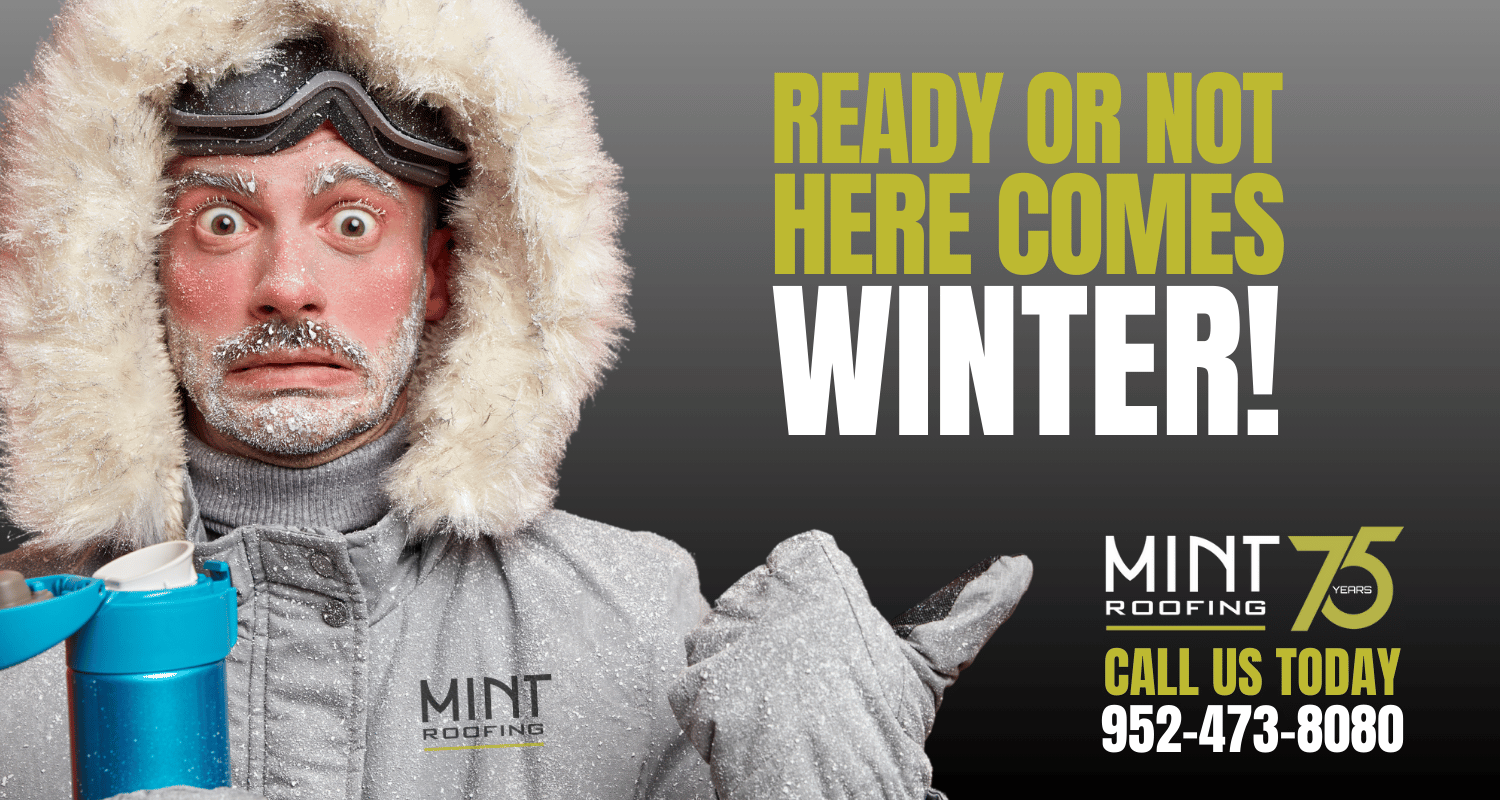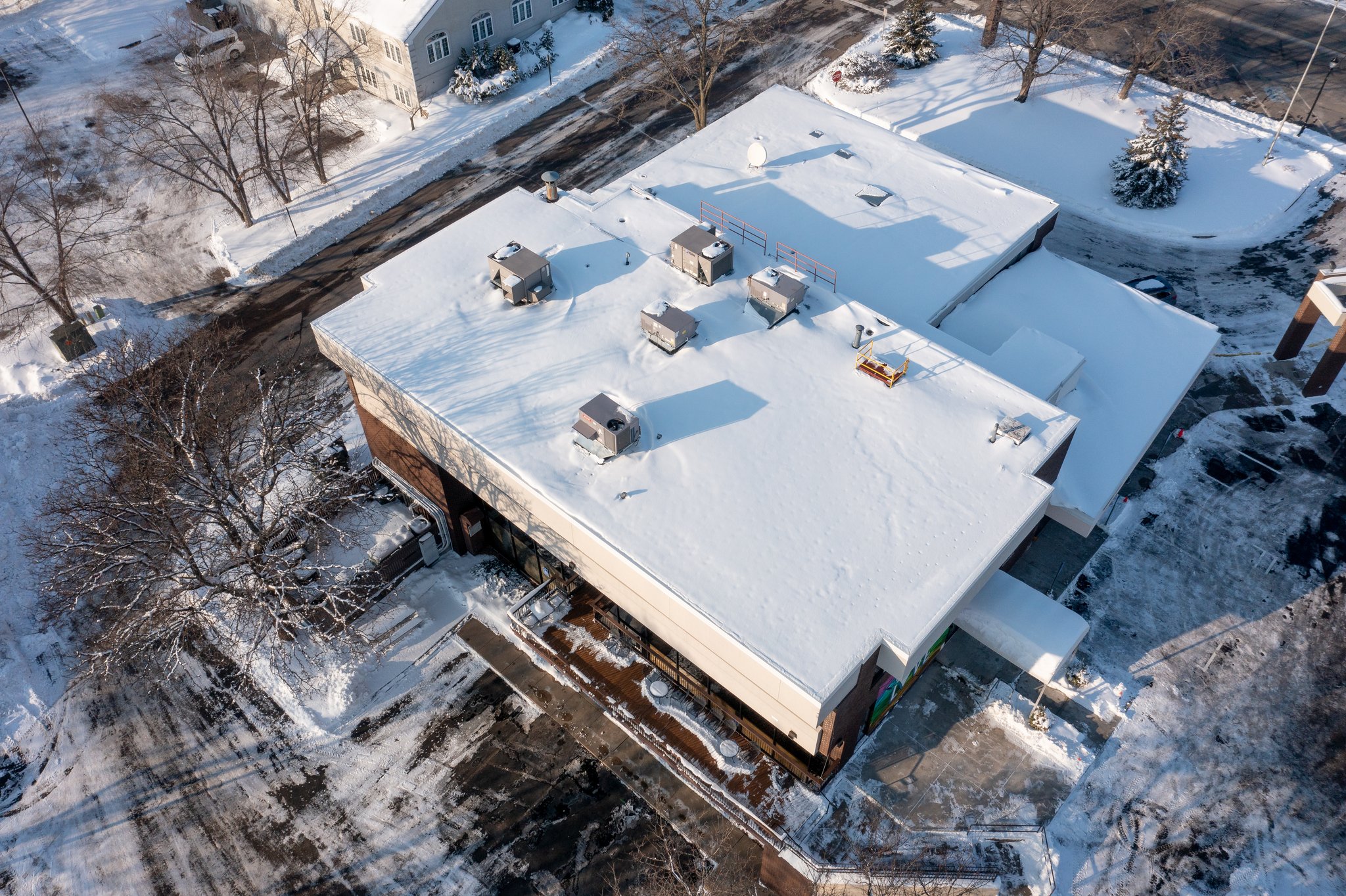Prevent Snow Buildup on Your Commercial Roof with Mint Roofing’s Commercial Roof Snow Removal Services.
Are you ready for winter? Historically, December is the snowiest month of the winter in Minnesota. But with a changing climate comes unpredictability in forecasting the weather beyond a week or two.
While snowfall levels are not predictable with any accuracy, it is a certainty. Commercial flat roofs in Minnesota are likely to experience snow buildup during this season. This can cause leaks and other costly problems for commercial building owners and managers alike. Fortunately, there is a solution – commercial roof snow removal services from Mint Roofing.
Do I need to clear the snow from my commercial roof?
The answer to this question depends on the type of roof, the weight of the snow, and the load capacity of your roof. Commercial property owners should generally schedule snow removal any time it gets to be more than two feet deep.
What should I watch out for?
If you look up at your roof and see ice dams in the downspouts or snowdrifts over the edge of the roof, you’ll need to take immediate action. You may also hear cracking noises inside your building if your roof has too much weight on it.
If you witness any of these signs, you should have an expert check it out as soon as possible to prevent damage to either your roof structure or the interior contents of your building.
The weight of accumulated snow can cause a roof to collapse, causing damage to the contents of the building and serious injury or death to its occupants.
How much does the snow on my roof weigh?
The weight of snow varies significantly based on the moisture content – generally, the colder the temperature during the snowfall, the lower the weight. Snow’s water content can range from 5% to 32%. Snow falling on a 10° day has much less moisture content than snow falling at or near the freezing point. Snowfall on warmer days also tends to have higher accumulation.
One inch of fresh snow weighs between .25 and 1.65 pounds per square inch, meaning a 6″ heavy, wet snowfall could weigh 9.9 pounds per square foot. That doesn’t sound like much, but it means that a commercial roof with an area of just 1,000 square feet could potentially have more than 10,000 pounds of snow weight – just from a single 6″ snowfall.
Of course, we all know that it doesn’t snow just once each winter in Minnesota. Snow accumulates. And as snow accumulates, it compresses and increases in density, increasing the weight on your roof.

Combined with freezing and thawing weather cycles (and even winter rain), the bottom layer of accumulated snow eventually turns to ice. Ice weighs as much as five times the weight of even heavy fallen snow. When your 6″ of snow turns to ice, and it snows just six more inches, your 1,000 square foot roof could now be supporting as much as 60,000 pounds! That’s like parking 20 Honda Civics on a 20′ x 50′ roof!
In addition to the increased weight, this layer of ice can prevent your roof from draining as designed. The presence of ice dams means no water is leaving the roof and that the scuppers are blocked as well.
Under intense pressure from the weight pushing down on it, melting water will try to escape wherever it can. With nowhere to go, the hydroponic pressure finds weaknesses in your roof structure, and the water may force its way inside your building.
Drifting snow makes matters even worse.
As the wind blows the snow around on your roof, it will invariably cause snow to drift in certain areas. Drifting causes snow weight to be concentrated in a smaller area of your roof, increasing the load per square foot. Increased load means a greater risk for roof damage – from leaks to roof collapse.
Should I try to clear snow on my commercial roof?
If you’re a commercial building owner or manager who is trying to decide whether it’s safe and effective to clear snow off your commercial flat roof on your own. We always advise our clients against attempting to do this on their own.
Damage from snow improper snow removal can cause costly repairs to your roof. Shoveling or blowing snow from your commercial roof snow risks damaging gutters, soffits, and even the roof surface itself. The type of roof you have determines the safest method to use.
The other issue faced by facility managers is that of roof access. The weight of even a moderate snowfall can make it impossible to open access hatches and doors. When this happens, the only way to access your roof is from the outside, requiring a ladder or more elaborate lift equipment.
If your roof is large, you’re going to have a lot of snow to move. Removing snow from large commercial flat roofs takes a lot of time and effort. And depending on your building’s location, you need to know where the snow should go and how to get it there safely. Great care needs to be taken to prevent snow from landing on cars, property, or people below.
It’s just not worth the risk to try to clear snow from your roof yourself.
How Mint Roofing Can Help
At Mint Roofing, we understand the importance of keeping snow under control when it comes to your commercial roof. We employ several different methods:
- Shoveling
- Raking
- Snow-blowing
- Steam
Different roof construction requires different approaches. For example, we can shovel a built-up roof, but we cannot shover a membrane roof without risking damaging it.
While you don’t have to be a Mint Roofing customer to use our snow removal services, existing clients receive priority scheduling. Please note that our TopSite Preventative Maintenance Program does not include the cost of snow removal.
At Mint Roofing, we have all the equipment and techs to remove the snow from your roof safely. In most cases, a structural engineer will be involved to assess your roof and supervise the removal process.
If equipment is needed to remove the snow, we can crane up the equipment on large roofs.
Let us do the heavy lifting!
Mint Roofing offers commercial roof snow removal services which will help keep your commercial flat roof free from ice dams and costly repairs throughout the long Minnesota winter. For more information on our commercial roof snow removal services, please visit our website at www.mintroofing.com or call us today at (952) 473-8080.

FAQs
Q: Do I need to clear the snow from my commercial roof?
A: The need to clear snow from your commercial roof depends on various factors, including the type of roof, snow weight, and load capacity. As a general guideline, commercial property owners should schedule snow removal whenever the snow accumulation exceeds two feet. It’s essential to monitor your roof during winter, and if you notice excessive snow buildup, it’s time to take action to prevent potential damage.
Q: What signs should I watch out for to determine if I need snow removal?
A: There are several signs that indicate the need for snow removal. If you see ice dams in the downspouts or snowdrifts over the edge of your roof, it’s a clear indication that you should take immediate action. Additionally, be attentive to cracking noises inside your building, as this may be a sign of excessive snow weight on your roof. These signs should prompt you to have an expert inspect your roof promptly to prevent damage to both your roof structure and the contents of your building.
Q: How much does the snow on my roof weigh?
A: The weight of snow on your roof varies depending on the moisture content, which is influenced by temperature. In colder conditions, snow tends to have lower moisture content, while warmer temperatures result in higher moisture content. On average, one inch of fresh snow weighs between 0.25 and 1.65 pounds per square inch. A six-inch snowfall with heavy moisture could weigh as much as 9.9 pounds per square foot. Snow accumulates over the winter, and as it compresses and turns to ice, it can weigh up to five times more than the original snow.
Q: Should I attempt to clear snow on my commercial roof myself?
A: We strongly advise against attempting to clear snow from your commercial roof on your own. Improper snow removal can lead to costly roof repairs and potential damage to gutters, soffits, and the roof surface. The method for safely removing snow depends on the type of roof you have. Moreover, accessing the roof during heavy snowfall can be challenging due to roof access hatches and doors becoming blocked. Large roofs require significant time and effort to clear, and great care is needed to ensure that snow doesn’t land on property or people below. Given these risks, it’s not worth attempting to clear snow yourself.
Q: How can Mint Roofing help with commercial roof snow removal?
A: Mint Roofing offers professional commercial roof snow removal services to keep your commercial flat roof free from ice dams and costly repairs during Minnesota’s winter. Our methods include shoveling, raking, snow-blowing, and even using steam, depending on your roof’s construction.
We have the equipment and trained technicians to safely remove snow, and in many cases, a structural engineer is involved to assess the roof and supervise the removal process. If needed, we can even crane equipment onto large roofs. Whether you’re an existing Mint Roofing client or not, we’re here to help ensure your roof remains in top condition during winter. Visit our website at www.mintroofing.com or call us at (952) 473-8080 for more information on our commercial roof snow removal services.
Q: What are the potential consequences of neglecting snow removal from my commercial roof?
A: Neglecting snow removal from your commercial roof can have serious consequences. The weight of accumulated snow can lead to structural damage, potentially causing your roof to collapse. This not only results in expensive repairs but also poses a significant safety risk to the occupants of your building. In addition, as snow accumulates and turns to ice, it can block proper drainage and lead to ice dams. Ice dams prevent water from leaving the roof, increasing the risk of water intrusion into your building. Drifting snow exacerbates the situation by concentrating snow weight in specific areas, putting additional stress on your roof and increasing the likelihood of leaks and damage.


